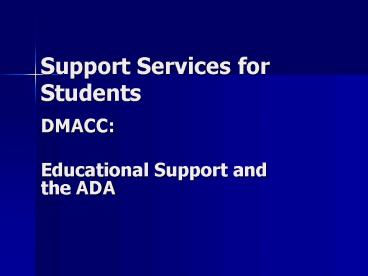Support Services for Students - PowerPoint PPT Presentation
1 / 24
Title:
Support Services for Students
Description:
Special Needs Coordinator who grants accommodations district-wide ... Do not lower your behavioral standards as a disability-related accommodation. ... – PowerPoint PPT presentation
Number of Views:48
Avg rating:3.0/5.0
Title: Support Services for Students
1
Support Services for Students
- DMACC
- Educational Support and the ADA
2
Support Services Offered at DMACC
- Services for Students with Disabilities
- Special Needs Coordinator who grants
accommodations district-wide - Counselor/Advisor on each campus to support
students with disabilities - Interpreters who provide services in the
classroom to students who are deaf - Academic Achievement Center
- Tutoring
- Preparatory Courses
3
Handouts
4
Quiz
5
Support for Students who are Deaf
- Having an Interpreter in the Classroom
- Notification
- Interactions with the Student
- Lecture Style
- Need for Closed Captioned Videos
6
Before Accommodations After Accommodations
7
Accommodations
- Provide for equal access in the classroom and for
classroom related activities - Process
8
Students with Disabilities that Impact Learning
- Challenges for Students?
- Consistent attendance
- Changes within the classroom, such as moving into
small group discussions, presenting or discussing
topics, reading aloud - Socialization with peers and the instructor
- Testing
- Reading print material
- Computer Access
- What?
- Depression
- Anxiety disorders
- Bi-polar disorder
- Autism/Asperger's Syndrome
- Schizophrenia
- Deaf
- Learning Disabilities
- Mobility Challenges
- Visual Challenges
9
Accommodation Challenges
- Testing
- Pop quizzes
- Tests given after lectures
- Delivery and pick up of exams to the Academic
Achievement Center - Maintaining Confidentiality
- No disclosure of students disability to others
- Taking care to not single out the student in the
classroom
- Lab Assistants
- Extra person in class
- Need for discussion between the student and Lab
Assistant - Interpreters
- Initially distracting
- Require a slower speaking pace from the
instructor and some behavioral changes
10
- Addressing
- the
- Challenges
11
General Strategy
- Universal Design
12
Universal Design
- Provide a detailed course syllabus
- Maintain a syllabus with minimal changes
- Announce reading assignments well in advance
- Provide an outline of material to be covered that
day
13
Universal Design
- Briefly summarize key points at the end of the
lecture - Avoid speaking while writing
- Create a course Website
14
Universal Design
- Allow students to tape record your lectures.
- Schedule review sessions
- Discuss the format of your tests
15
Universal Design
- Provide a sample test
- Provide copies of overheads and/or handouts of
PowerPoint slides - Use email to provide links that enhance the
learning opportunities
16
Other Strategies
- Disabilities that Impact Learning
- Have an attendance policy written in your
syllabus - Inform students early on regarding group
discussions, class participation, or reading
aloud. Invite students to share concerns with
you. - Give students various ways to contact you
depending on their comfort level. Email may be
the preferred contact for some students. - Give as much information regarding tests as
possible. - Ensure that tests are placed in the AAC prior to
the date and time of the exam to lessen student
anxiety. - Speak with students in a quiet, private area
regarding classroom expectations should
inappropriate classroom behavior occur.
17
Other Strategies Continued
- Work with the special needs coordinator to plan
for pop quizzes and tests given after lectures - With Lab Assistant Assess seating needs
depending on the communication required between
the student and LA - Meet with the student and LA early to develop
classroom strategies and expectations - Introduce interpreters to the class and indicate
their role, but do not single out for whom they
are interpreting.
18
Other Strategies continued
- Speak when facing the class, so the student can
read your facial expressions. - Work with the interpreters to ensure closed
captioning is available for videos - Try and maintain a slow and steady lecturing
pace. - For students with medical issues, work with the
student or special needs coordinator ahead of
time to know what to do in an emergency.
19
Needed Intervention
20
Addressing Problem Behavior in the Classroom
- Suppose you have a disruptive student in your
class who has been identified as a student with a
disability. What should you do? - Discuss the problem with the student in private.
- Do not lower your behavioral standards as a
disability-related accommodation.
21
Addressing Problem Behaviors in the
ClassroomContinued
- Inform the student of behavioral expectations in
the classroom. - Contact Pamela Parker, the special needs
coordinator, for support.
22
The Art of Referral
- How do you suggest to a student that they seek
help? - Avoid arm chair diagnosing.
23
Be proactive...use your syllabus
- Behavioral expectations
- Grading policies
- Attendance expectations
- Disability statement
- Refer to student conduct policies
- Contact information
- Office hours
24
Resources
- http//www.dmacc.edu/student_services/disabilities
.asp - http//www.dmacc.edu/student_services/tutoring.asp
- http//www.dmacc.edu/student_services/academic_ach
ievement_center.asp - sgbittner_at_dmacc.edu
- pjparker_at_dmacc.edu
- sahill_at_dmacc.edu































